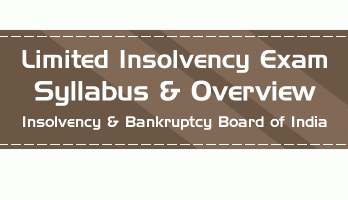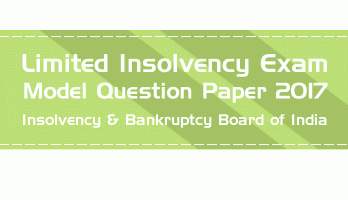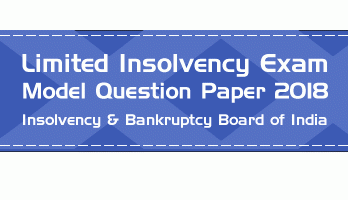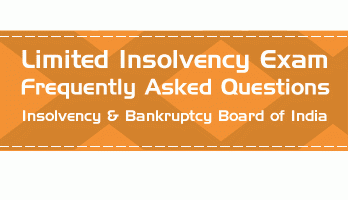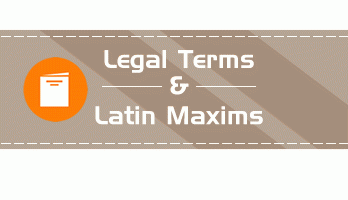26. Any transfer of property, not being a transfer or delivery made in the ordinary course of a company business, if made within a period of one year before the presentation of a petition for winding up by the Tribunal shall be against the Company Liquidator.
(a) valid
(b) voidable
(c) void
(d) an offence
Ans. (c)
27. A corporate applicant is required to dispatch the application filed with the National Company Law Tribunal for initiation of corporate insolvency resolution to the registered office of
(a) all the financial creditors.
(b) operational creditors.
(c) corporate debtor.
(d) all the creditors.
Ans. (c)
28. An Interim Resolution Professional incurred an expenditure of Rs. 2 lakh on public announcement of a corporate insolvency resolution process. If the committee of creditors ratified an expenditure of Rs. 50,000 for the public announcement,
(a) the remaining amount will be borne by the applicant.
(b) the matter will be brought to the notice of NCLT for directions.
(c) the total amount of Rs.2 lakh will be insolvency resolution process cost.
(d) the remaining amount will become part of insolvency resolution process cost.
Ans. (a)
29. The existence of debt due to an operational creditor under corporate insolvency resolution process may be proved on the basis of a contract for the supply of to the corporate debtor.
(a) goods only
(b) services only
(c) goods and services
(d) professional services only
Ans. (c)
30. Where all financial creditors are related parties of the corporate debtor, the committee of creditors shall comprise
(a) debenture holders.
(b) all operational creditors.
(c) insolvency resolution professional and operational creditors.
(d) 18 largest operational creditors and one representative each of workmen and of employees.
Ans. (d)
31. In a resolution process of a company, the resolution professional appointed 2 valuers, who gave estimates of liquidation value of Rs.2 crore and Rs.5 crore respectively. The resolution professional then appointed another valuer who gave an estimate of Rs.3 crore. What is the liquidation value in the case?
(a) Rs.2.50 crore
(b) Rs.3.00 crore
(c) Rs.3.33 crore
(d) Rs.4.00 crore
Ans. (a)
32. Which of the following is not a mandatory content of a resolution plan?
(a) Liquidation value due to operational creditors
(b) Insolvency resolution process costs
(c) Plan for additional infusion of debt by creditors
(d) Adequate means for supervising the implementation of the resolution plan
Ans. (c)
33. Which of the following is not a requirement for a company to be registered as an insolvency professional agency?
(a) Its sole object is to carry on the functions of an insolvency professional agency.
(b) It has a minimum net worth of ten crore rupees.
(c) It is promoted by a statutory regulator.
(d) It is not under the control of person(s) resident outside India.
Ans. (c)
34. Which of the following statements is not true about disposal of the show cause notice issued to an insolvency professional agency?
(a) The order of disposal of show-cause notice becomes effective on the day of receipt of the order by the insolvency professional agency.
(b) The order of disposal of show-cause notice becomes effective ordinarily after thirty days of the date of issue of order.
(c) The Disciplinary Committee disposes of the show-cause notice by a reasoned order in adherence to principles of natural justice.
(d) The Disciplinary Committee endeavors to dispose of the show-cause notice within a period of six months of the assignment.
Ans. (a)
35. Which of the following statements is not true about bye-laws of an insolvency professional agency (IPA)?
(a) An IPA shall publish its bye-laws on its website.
(b) The Governing Board of the IPA may amend the bye-laws by a resolution passed by votes in favour being not less than three times the number of the votes, if any, cast against the resolution, by the directors.
(c) The amendments to the bye-laws shall come into effect on the 30th day of its publication in Gazette of India.
(d) The IPA shall file a printed copy of the amended bye-laws with the IBBI within fifteen days from the date when an amendment is made effective.
Ans. (c)
36. The Insolvency Professional Agency does not initiate disciplinary proceedings against a professional member based on
(a) a reference made by the Grievances Redressal Committee.
(b) monitoring of professional members.
(c) the recommendation of the Committee of Creditors.
(d) the directions given by the IBBI.
Ans. (c)
37. Which of the following is eligible for registration as an Insolvency Professional?
(a) A person resident of Nepal and having passed the National Insolvency Examination
(b) An advocate with 11 years of professional experience and having passed the Limited Insolvency Examination
(c) An MBA with 11 years of professional experience and having passed the Limited Insolvency Examination
(d) A chartered Accountant with 15 years of professional experience and having attempted National Insolvency Examination
Ans. (b)
38. An insolvency professional agency shall inform the IBBI within days, if any of its professional members has temporarily surrendered his certificate of membership.
(a) seven
(b) five
(c) fifteen
(d) eight
Ans. (a)
39. Which of the following is not covered by the code of conduct for insolvency professionals?
(a) An insolvency professional should not act mala fide or be negligent while performing his functions and duties.
(b) An insolvency professional should not take up corporate insolvency resolution processes of two corporate debtors simultaneously.
(c) An insolvency professional should not accept gifts or hospitality which undermines or affects his independence as an insolvency professional.
(d) An insolvency professional should not conduct business which in the opinion of the IBBI is inconsistent with the reputation of the profession.
Ans. (b)
40. Who decides the fees payable to a liquidator under the IBBI (Liquidation Process) Regulations?
(a) Committee of Creditors
(b) Corporate Debtor
(c) IBBI
(d) Adjudicating Authority
Ans. (a)
41. The Preliminary Report under the IBBI (Liquidation Process) Regulations, 2016 may not contain
(a) the capital structure of the corporate debtor.
(b) the details of the onerous property.
(c) the proposed plan of action for carrying out the liquidation.
(d) the estimates of assets and liabilities of the corporate debtor on the liquidation commencement date.
Ans. (b)
42. Which of the following may not prove existence of debt due to an operational creditor under the IBBI (Liquidation Process) Regulations, 2016?
(a) Records available with an information utility
(b) A charge registered with Registrar of Companies
(c) A contract for the supply of goods and services
(d) An invoice demanding payment for the goods and services supplied
Ans. (b)
43. The option to sell the assets of a corporate debtor by means of private sale under the IBBI (Liquidation Process) Regulations, 2016 is not available to a liquidator if the asset is
(a) Perishable.
(b) sold at a price lower than the reserve price of a failed auction.
(c) likely to deteriorate in value if not sold immediately.
(d) sold at a price higher than the reserve price of a failed auction.
Ans. (b)
44. Which of the following is eligible to voluntarily liquidate itself?
(a) Where the committee of creditors decides to liquidate the company during the resolution period
(b) Where the adjudicating authority does not receive a resolution plan of a company
(c) Where the company has no debt or can pay all its debts in full.
(d) Where debt equity ratio of the company is less than one.
Ans. (c)
45. A professional engaged by the liquidator in a voluntary liquidation process will have
(a) remuneration from the fees paid to the liquidator.
(b) reasonable remuneration which shall form part of liquidation cost.
(c) remuneration as decided by the adjudicating authority.
(d) remuneration as decided by the committee of creditors.
Ans. (b)
46. The Annual Status Report indicating progress of the voluntary liquidation is not required to include the
(a) details of assets that are yet to be sold.
(b) distribution made to stakeholders.
(c) cost of realization of the assets.
(d) developments in any material litigation.
Ans. (c)
47. Which of the following is not a requirement for registration as an information utility?
(a) It has a minimum net worth of Rs.100 crore.
(b) Not more than 49% of its voting power is held by persons resident outside India.
(c) At least 50% of its directors are independent directors.
(d) Its sole object is to provide core services and other services under the IBBI (Information Utilities) Regulations, 2017.
Ans. (a)
48. The responsibilities of the Technical Committee under the IBBI (Information Utilities) Regulations, 2017, include
(a) identification of chief technology officers of Information Utilities.
(b) shortlisting of applicants for registration as Information Utilities.
(c) recommendations to the IBBI for laying Technical Standards.
(d) evaluation of technology used by the Information Utilities.
Ans. (c)
49. An information utility holds financial information as a
(a) trustee.
(b) Regulator.
(c) Custodian.
(d) Fiduciary.
Ans. (c)
50. In a Fast Track Insolvency Resolution Process, the Adjudicating Authority may extend the duration of such process not exceeding
(a) 30 days
(b) 45 days
(c) 60 days
(d) 90 days
Ans. (b)


